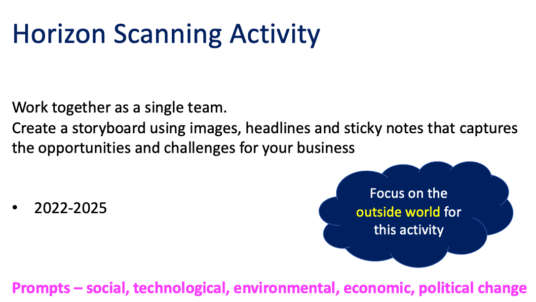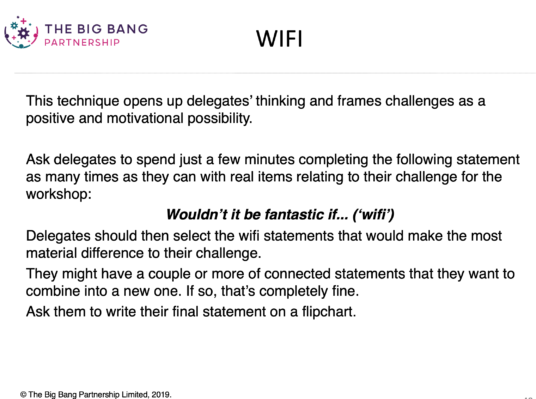Posted in Blog, Entrepreneurship, Facilitation, Innovation, Innovation, Intrapreneurship, Launch Your Business, Lead, Virtual Facilitation by Jo North
Business Strategy Workshops
This article gives you practical tips and advice for planning and delivering an awesome business strategy workshop.
I believe that business strategy sessions are one of the most important things that we do. The world around us is always changing. Businesses need to stay agile, make sure they’re ahead of the curve and in line with where the markets are going.
It’s important to get everybody engaged and thinking differently in your business strategy workshop, and I’ll be sharing some ideas along the way about how you can do that.
What is Business Strategy and Who is it For?
A business strategy is really just an overarching plan for an organization.
Big or small, all businesses need a strategy, and the world is changing all the time. It’s important that we revisit the strategy frequently to make sure it’s on course, adjusting where necessary.
Some of the strategic plans that we make don’t actually play out over time. However, having a business strategy creates direction, helps with prioritization and gets everyone working towards achieving the same vision.
Objectives of a Business Strategy Workshop
The objectives of a business strategy workshop are for the organization to think about what’s going on in the world outside in relation to the organization’s vision, mission and values.
Where does the organization want to be in relation to the world around it?
- How do you want to compete?
- How do you want to deliver value?
- How do you want to achieve your purpose?
From there, realign with the customer elements.
- Who are you serving?
- How have your customers’ needs changed?
- How have your competitors’ activities changed over time?
This is really about setting a long-term view, but how long term depends on the industry that you’re in.
The energy and utilities sectors, amongst others, have really long-range planning of at least 10-15 years ahead. However, if you’ve got a small business, you might be looking at just the next 1 to 5 years.
The Opportunity
The world has never been in the place it’s in today, and I think we’re seeing a lot of unprecedented change at the moment with…
- Post COVID recovery. Organizations are working out what happens now, what the future may hold, and how we need to change in light of that.
- Climate change. We have organizations thinking about how they can do things cleaner, better with net zero decarbonisation.
- Technology. The availability of new technology means that customers’ expectations are changing. Digital technology also means that we can streamline internal processes for increased business efficiency.
- Social change. We are all in business to solve a problem, or problems, that our customers have. Because the world is always changing, our customers’ needs and aspirations are always changing too. We need to make sure that the business’ value proposition remains aligned with market requirements.
Sometimes organizations don’t think they need a strategy. They don’t believe they can plan for the future because of all the changes.
However, having a strategy is about having a direction. It’s about knowing where the organization wants to be so that it can build appropriate plans that it can then flex and change on its journey to get there.
In preparing for battle I have always found that plans are useless, but planning is indispensable.
Dwight D Eisenhower
Getting Ready for Your Business Strategy Workshop
In preparing for a business strategy session, you’ll want to take the individual circumstances of each organization into account. I always establish objectives with clients ahead of time.
- What do people need to know?
- What pre-work is needed?
- What information and inputs are needed for the strategy session?
- Why are all those inputs needed?
- Who can provide and deliver them?
- When do we need to get them and from where?
- What data or info needs to be shared?
This helps delegates process the information in advance of the strategy workshop, so they come after having done some groundwork. It also means that you have any important information at your fingertips, ready to use.
Designing Your Business Strategy Workshop
Business Strategy Workshop Activities
Welcome and Warm up
There are many different icebreakers and energizers that you can do to warm people up. My article here will give you loads of great activities that you can use. Also, you’ll find some brilliant icebreaker questions specifically for your business strategy workshop here.
Where Do We Want To Be, and Why?
I recommend that you dedicate a significant proportion of your workshop to exploring the answers to this question, using a combination of activities that I’ve shared below.
Horizon Scanning
Start off with an activity that I have created called ‘Horizon Scanning’.
Horizon Scanning is about looking forward and reading the signals of today’s significant trends and seeing how they might evolve going forward.

When I’m working online, I ask delegates to use a virtual whiteboard in a tool such as Miro Online Whiteboard, and create an image with sticky notes for the things they think are going on in the future that will affect the organization’s strategy.
If I’m facilitating in person, I like to have newspapers, industry publications or journals the delegates will use to find things that they think are going to be relevant to the company strategy from outside the organization.
I have delegates break into small groups and look at the opportunities and challenges the business might have, for example, between now and the end of 2025.
We have a discussion about what the social, technological, environmental, economic, political, legal and regulatory changes might mean for the organization in the years ahead.
Business mission, vision, values
We are still working on the question “Where do we want to be, and why?”
Now, you want to take a look at the organization’s vision, mission and values, and consider the organization’s intended place and role in the changing world.
- Where do you see your place in the world, amongst all of those things that are going on in the world outside?
- Where do you see your purpose, fit, place and contribution?
If the organization you’re working with does not have a mission, vision and values, use the activities in my article here to create them.
Wouldn’t It Be Fantastic If…
Having established what’s going on in the world outside of your business and how that might impact your organization, the next stage of the business strategy workshop is to determine:
‘Given our vision, mission and values, where do we want to be and how does that relate to us?’
‘What might a great future be like within the context of your vision, mission values and what’s going on in the world?‘
A really simple and effective exercise is to ask delegates to do the WIFI (Wouldn’t It Be Fantastic If) activity.
I ask delegates to complete the phrase, Wouldn’t It be Fantastic If, as many times as they can for things that they could make happen. These need to be things they CAN make happen, not just wishful thinking!
Once you are done with that, your strategy workshop participants select the top ones. This is where you’re really starting to envision where the organization wants to go.

I like to use Wouldn’t it be fantastic if... because it’s all about possibility and imagination. It gives people the freedom and the permission to think differently, stretch themselves, and dream a little bit as well.
Lightning Talks with Customers
Now look at how customer’s needs are changing. I’m defining customers in the loosest possible sense. If we do something for somebody else, that ‘somebody else’ is our customer. So make sure that you’re specific about who your organization’s customers are.
When I work with an organization, I often invite a selected number of the organization’s customers in to do something that I call a lightning talk.
A lightning talk is designed to really spark creativity, insights and ideas. It’s fast and punchy, but it’s packed with value. The purpose is to get ideas sparking and delegates really thinking through the lens of their customers.
I ask customers at this stage to share their thoughts, experiences and future priorities.
TIP: If you have a small business and you’re not sure how this would work for you, you can simply contact some customers and have conversations with them, get some input from them and feed that into your own strategy process.
Product / Service Life Cycle
Next, explore the products or services that the organization is providing using the product / service lifecyle model.
I ask delegates to plot out where each element of their offer is in the lifecycle.
- Is it in a growth phase?
- Are there some elements that are declining?
This stage is important because you’re thinking through what’s working, what’s growing and what to get behind.
You may also focus on those products or services that may need another growth curve, or what you should turn off or let go in order for resources to be directed somewhere else.
Using the product / service lifecycle tells us about customers’ behavior. It highlights what customers want, what they’re enjoying, what they’re benefiting from, and also what isn’t so popular and why. As an alternative, you can do this using the Boston Consulting Group matrix (pictured below).
With the Boston Consulting Group matrix, you’re looking at sales and growth and plotting them in one of the four squares: Stars, Cash Cows, Dogs or Question Marks.
- Stars – Fast growing products or services that might not be selling a huge amount of volume yet, but they’re showing some really fantastic promise.
- Dogs – Products or services that are not going anywhere and are probably not at all profitable.
- Cash Cows – Products or services which aren’t growing a lot, but are steady and bringing in a nice profitable income. The cash cows provide the cash flow to fund innovations for stars and future cash cows.
- Question Marks – Products or services that do not seem to have a clear path for success. They could either succeed or fail. The question is do you get behind it, leave it a bit longer, or maybe put it to one side and focus on something else?
Mapping all of the business’ products and services out in this way helps to identify where the priorities might be, as well as understanding where customers are heading with their choices.
Competition
Next, explore competition with delegates to understand how well competitors are serving customers. Discuss how well competitors are showing that they might be serving customers going forward.
I ask delegates to plot out how well competitors are performing versus themselves and give themselves a score using a visual template, such as in the image below.
For more information and a detailed step-by-step guide on how to do competitor analysis, check out my article here and video below.
How it all Fits Together
So we’ve been divergent up to this point, and now we’re going to look at being more convergent.
It is usually at this point that I’ll ask delegates to do a SOAR analysis. SOAR stands for Strengths, Opportunities, Aspirations and Results.
Related Article: Appreciative Inquiry for Facilitators
In a SOAR analysis, I’ll ask the team to think about and work through the following:
- The organization’s greatest assets – people, money, the brand, ways of working, products, services, networks, supply chain, and many more things.
- Key opportunities coming from the outside world from the earlier horizon scanning activity.
- Internal weakness – these can be converted into a strength internally, so that could be an opportunity for growth.
- Mapping out and consolidating their aspirations from the WIFI activity above.
- Identify the measurable results that they want their strategy to achieve.
This is where you are bringing everything together from all the activities that the team has done so far. Pull them into one place to create a consolidated SOAR analysis.
Potential Solutions
We now know where we want to be, where we are and what we have to work with. But, how are we going to do that and create competitive differentiation?
There are so many different tools that I use for this. One really good one is the Four Actions Framework from the Blue Ocean Strategy suite of tools.
So the next activity is about asking the team to think through what they could:
- Eliminate
- Reduce
- Raise
- Reduce
The idea is to eliminate or reduce things without negatively impacting the customer experience.
These simple questions are really fantastic at prompting great strategic thinking and you get lots of ideas from that which you prioritize.
Action Plan
The last thing is to create an action plan.
- What’s the action?
- Who’s going to do it?
- When does it need to be done by?
You want everybody to leave the business strategy workshop being superclear about where the organization’s heading. This includes what it means for customers and where the competitive differentiation is going to come from. Also, on what the organization needs to put in place and start doing in order to make that happen. It’s important too to have a clear segue into actually getting there.
Next Steps
If you’d like our help with designing and facilitating your business strategy workshop, either virtually or in-person, please do get in touch. We’d love to help.
If you’re interested in facilitation and developing your professional practice as a facilitator, I’d love you to come and join me in my free, private Facebook Group, Idea Time for Workshop Facilitators. As well as a fantastic community of likeminded people, you will get access to free facilitation trainings, tools, techniques and time savers.
If you’d like to book us to deliver some professional virtual facilitation for you and your team, or would like a one-to-one virtual facilitation training and coaching session, find out more about what we do here. Contact me direct using the form below. I’ll get straight back to you.
Hope to hear from you soon 🙂

